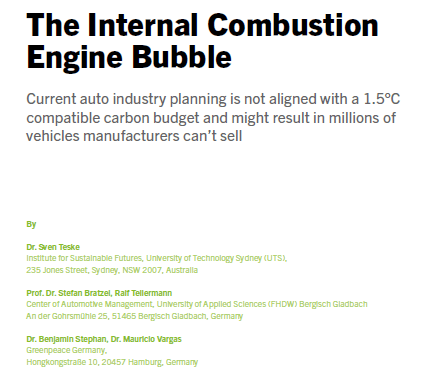The report „The Internal Combustion Engine Bubble“ assesses the disconnect between traditional automakers’ sales targets and the volume of diesel and petrol vehicle sales that is feasible under the Paris Agreement 1.5°C limit. Researchers find that automakers must accelerate their transition to zero-emission vehicles or risk both mounting financial losses and climate catastrophe.
The internal combustion engine (ICE) needs to be phased out, and the vehicle fleet needs to be electrified
to make road transport compatible with the Paris Agreement’s goal of limiting warming to 1.5°C.
However, just how fast this transition must happen, what it means for the auto industry and whether the
companies’ planning delivers what is needed to comply with the 1.5°C goal remains unclear. This report
aims to shed light on these questions. It defines the number of ICE vehicles that could still be sold within
a 1.5°C carbon trajectory and projects the auto industry’s ICE sales based on the assessment of four
major manufacturers’ plans – Toyota, Volkswagen, Hyundai / Kia and General Motors – and quantifies
the overshoot.
To do so, this report draws on the concept of the “carbon bubble” – fossil fuel reserves in the books of
energy companies that need to remain in the ground if we are not to exceed 1.5°C of warming.1 These
unburnable reserves result in stranded assets and pose significant other financial risks for companies
and their investors. This study applies the bubble concept and examines the extent to which these risks
exist in the transport sector.
The body of this report consists of three key chapters: Chapter 2 lays out how many light-duty vehicles
(LDV) – cars and vans – with internal combustion engines can still be sold worldwide before the global
CO₂ budget for limiting a temperature increase to a maximum of 1.5˚C is exhausted. Current and future
trajectories for car sales are broken down into five drive-train technologies with four different engine
sizes. The aim of this analysis is not to forecast the possible market development of the global LDV
market but to develop a 1.5°C-compliant benchmark for sales trends in the auto sector. The analysis
concludes in a quantified amount of ICE vehicles which can be sold before the manufacturing of internal
combustion engines needs to cease globally. Chapter 3 projects future ICE sales of Toyota, Volkswagen,
Hyundai/Kia and General Motors based on the companies’ announced sales targets for electric vehicles.
Chapter 4 identifies the gap between the manufacturers’ projected future sales and the number of
ICE vehicle sales compatible with a 1.5°C carbon trajectory. As governments are expected to increase
legislative and regulatory efforts to comply with the 1.5°C target of the Paris Agreement, this gap – an
ICE bubble – is expected to become an increasing business and financial risk.
Methodology
Researchers from the Institute for Sustainable Futures, University of Technology Sydney and the Center
of Automotive Management, University of Applied Sciences (FHDW) Bergisch Gladbach determined
the maximum number of diesel and petrol cars and vans that can be sold within a 1.5°C-aligned
carbon budget based on the Institute for Sustainable Futures’ One Earth Climate Model. They then
projected future auto industry sales based on an assessment of battery electric vehicle sales quotas and
combustion engine phase out dates announced by four major auto manufacturers: Toyota, Volkswagen,
Hyundai / Kia and General Motors. Sales projections are based on three scenarios that have been
modeled for each manufacturer: an S-curve transition scenario to battery electric vehicles (BEVs), a
linear transition scenario, and a combined scenario that serves as the base case.
Researchers identified a carbon budget of 53 Gt CO₂ for light-duty vehicles during the period 2020 to
2050, based on a global carbon budget of 400 Gt for the same period. A global carbon budget of 400
Gt by 2050 would limit warming to 1.5°C with a likelihood of 67%, according to the Intergovernmental
Panel on Climate Change (IPCC).4
More information: https://www.greenpeace.de/publikationen/internal-combustion-engine-bubble
Scientific Paper: Energies 2022, 15(21) https://www.mdpi.com/1996-1073/15/21/8037

